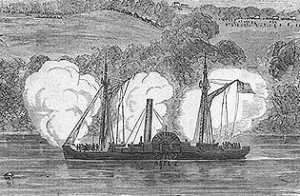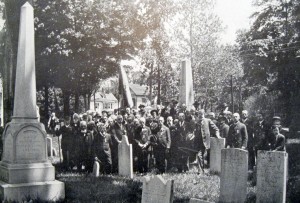Serious students of the Battle of Gettysburg know that what we now know as Barlow’s Knoll was once Blocher’s Knoll, named after the family that owned that land around it. Serious students of the 17th CVI know that the veterans of the regiment erected a flagpole on the knoll to commemorate the spot that Lieutenant Colonel Doug Fowler was killed on July 1st.
For years the national colors were raised and lowered on that flagpole by one David Blocher, and for that particular service he was honored by the veterans of the regiment during their visit to the battlefield in October 1889 to dedicate the regiment’s monument on East Cemetery Hill. Although the full story of that visit is elsewhere on this site, I’ve posted the part pertinent to this post here:
“During the evening the members of the regiments and their friends assembled at the Opera House, adjoining the McClellan House, when the meeting was called to order by Colonel Henry Huss, of Mt. Vernon, N.Y., who announced General Noble as the president of the meeting. On the platform were Rev. Mr. Warner, Rev. Dr. Thompson, General F. D. Sloat, Past Department Commander I. B. Hyatt, Major Doty, Sergeant Wade, Colonel George M. White, George C. Waldo and others.
Colonel Huss acted as Master of Ceremonies, and General Noble presented Mr. Blocher, of Gettysburg, (whose residence is near the first Seventeenth Regiment Monument, and who had for the past five years attended to the raising of the National Colors on the flag staff at Barlow’s Knoll) with a handsomely framed set of engrossed resolutions. Owing to the feebleness of Mr. Blocher, the response was made in his behalf by Rev. Mr.Warner.”
I spend a little time on most days (and a lot of time on many days) searching for stories that relate to the 17th CVI and recently came across a post on the Pastor’s Blog on the site of the Zion Arendtsville United Church of Christ. The post was written by the Reverend Kim Blocher. It turns out that Pastor Kim is the great, great granddaughter of David Blocher and currently has this “handsomely framed set of engrossed resolutions” hanging on her wall! The full resolution reads:
“TRIBUTE OF THE Seventeenth Regiment Connecticut Volunteers TO D.BLOCHER ESQ., GETTYSBURG. At their twenty-fourth Annual Re-union on the 28th day of August 1889, the following resolutions were adopted unanimously, with cheers. RECOGNIZES: D. Blocher who has, since this regiment’s monument was erected at Barlow’s Knoll, on the battle field of Gettysburg, voluntarily raised above it the flag of our county, therefore RESOLVED:
That we tender to him our thanks and affectionate regard for his good kindness.
RESOLVED: That we hope for him and his, many years of happiness and joyful memory of that great victory, made for freedom and the flag in part by this regiment in the desperate struggle so near his doors.
RESOLVED: That those resolutions be properly engrossed and framed and presented to the said D. Blocher.”
Of course, this was interesting, but the story told by Pastor Kim about her great, great grandfather was even more interesting. I’ll summarize it since you can read it on Pastor Kim’s blog (and she tells it better in the context of a deeper meaning), but David Blocher was REVEREND David Blocher, a minister in the German Brethren church that was located on Black Horse Tavern Road. We know them better as Dunkard’s. He was a conscientious objector during the war (although I think he was old enough to avoid the draft if called, but the Brethren – a pacifist church – would raise funds for substitutes as needed). As it turns out, the simple act of raising the flag each day was enough to get the Reverend Blocher in trouble with his church. Writes Pastor Kim:
This certificate landed Rev. Blocher in hot water at his church. The Brethren pastor who has been researching the Blocher farm found in the minutes of the church mention of discipline taken against David Blocher for participating in this civic action. Such activities as flag-raising were contrary to church teachings. That little Dunkard church was faithful in its commission of the gospel, holding each other accountable to their teachings. David Blocher knew those teachings, and yet every day for years, he walked from his farm to Barlow’s Knoll to raise the flag over the monument. What a fascinating conundrum for my great, great grandfather. A man of faith, a pacifist, and still he felt compelled to honor the men who valiantly struggled on his land. Right or wrong, I’m sure this was a time of personal testing for him and his family.”
I always say that you never know where you’ll find something interesting about the 17th CVI – or in this case someone who took time from his day, at odds with the tenets of the church he served, to honor the men that fought and died on the knoll bearing his families name.
Thanks, Pastor Kim, for sharing this.


